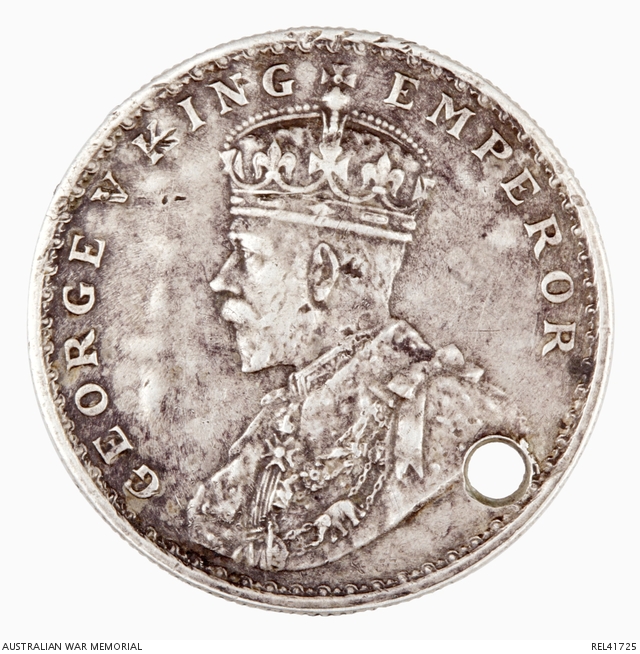| Place | Africa: Tanzania |
|---|---|
| Accession Number | REL41725 |
| Collection type | Heraldry |
| Object type | Heraldry |
| Physical description | Silver |
| Place made | India |
| Date made | c 1912-1936 |
| Conflict |
First World War, 1914-1918 |
Improvised identity disc : Private S E A Greentree, 11th South African Infantry



Improvised identity disc made from an Indian rupee coin. On the obverse is the bust of King George V and 'GEORGE KING EMPEROR'. The reverse has been ground down and roughly etched by hand with '11TH SAI 11681' in the centre, surrounded by 'S E A GREENTREE'. A 3 mm diameter hole has been punched through the edge of the coin.
Improvised identity disc worn by Septimus Ernest Athol Greentree while he was serving with the 11th South African Infantry in German East Africa during the First World War. Personal identity discs first became popular during the Boer War as a means of identifying casualties on the battlefield. They were officially issued during the First World War though improvised examples such as this were also made by soldiers.
Greentree was born on 22 January 1872 at Freeman's Reach, Hawkesbury, New South Wales, to Robert and Hannah Greentree. He travelled to South Africa and in June 1900 enlisted for service in the Boer War, joining 1st Battalion, Brabant's Horse, an irregular British South African unit. This highly mobile Light Horse unit was formed by then Brigadier General Edward Brabant, a South African colonial military commander. It was made up of approximately 600 South African colonials, Australians, British and Canadian soldiers and was heavily involved in fighting irregular Boer commando units, in particular in the Transvaal. Greentree attained the rank of corporal and in March 1901 was discharged from Brabant s Horse to serve as an agent with the South African Field Intelligence Division (FID). The FID conducted a diverse range of field intelligence activities and was considered highly effective at combating the Boers in South Africa.
Greentree was still living in South Africa when the First World War broke out in September 1914. Aged 42 he joined the Cape Garrison Artillery on 17 September 1914 at Cape Town and was assigned the regimental number A/51164. He served in German South West Africa (today known as Namibia) and was discharged on 29 July 1915 after the cessation of hostilities in this area.
Greentree re-joined the South African forces in Cape Town on 22 April 1916, this time as a private in the 11th South African Infantry with the regimental number 11681. The unit saw action against German colonial forces in East Africa. Greentree was discharged in Durban on 13 December 1916. He later returned to Australia and died in 1963 at Sydney, NSW, aged 90.
Related information
Conflicts
Units
Places
Subjects
Related Objects
- Greentree, Septimus Ernest Athol
- 'Omaruru Pass' identification token : S E A Greentree, Cape Garrison Artillery, South African Army
- Queen's South Africa Medal : Corporal S E A Greentree, Brabant's Horse
- King's South Africa Medal : Agent S E A Greentree, South African Field Intelligence Division
- 1914-15 Star : Gunner S E A Greentree, Cape Garrison Artillery, South African Army
- South African Soldiers' Association badge : S E A Greentree
- Souvenir pencil holder from Princess Mary Gift Tin : Gunner S E A Greentree, Cape Garrison Artillery, South African Army
- This image was published in the Sydney Morning Herald on Friday 13th October 1961 with the ...